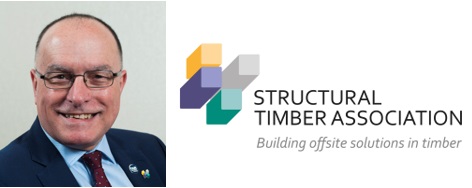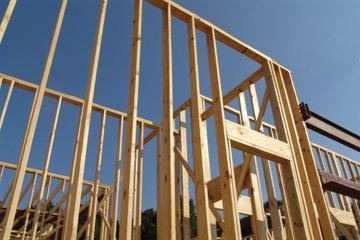Main author
Michael BrooksInterview with Structural Timber Association
The Structural Timber Association (STA)’s mission is to enhance quality and drive product innovation through technical guidance and research, underpinned by a members’ quality standard assessment - STA Assure.
Designing Buildings Wiki talked to Chief Executive Andrew Carpenter about the rising popularity of timber as well as common misconceptions, fire safety concerns and the future of 'plyscrapers'.
| Designing Buildings Wiki (DBW): How has the industry’s attitude towards timber changed in the nearly 7 years that you’ve been with STA? |
Andrew Carpenter (AC):
It's changed dramatically. In those days, the market was at a very low ebb, particularly with house developments. Since then, the market has picked up, and speed of build has become a big issue - obviously timber frame is much quicker than traditional methods.
The sustainability agenda is rumbling away, and you've now got the acknowledgement that housing is probably the number one political issue of the moment - that you're not going to build an additional 100,000 houses per year with traditional construction, offsite is the solution and offsite predominantly uses timber frame.
In terms of market share, we're seeing a significant increase, from about 27.5% in 2015/16 - the new figures will be announced at Timber Expo on 10 October 2017, when we launch our latest Timber Trends and Capacity report.
| DBW: Do you think we’ve got to the bottom of timber in terms of sustainability or is there more work to be done? Is it as high, or higher, on the agenda in other countries compared to the UK? |
AC:
I don't think decisions have been made on the sustainability issue to the extent that perhaps we think. The reason people are turning to timber is very much on the business case, in terms of speed of build, availability of products, and so on. We would like the sustainability card to be played more widely but I don't think it is at the moment, it's not the main reason people are turning to it.
This government did away with the Zero Carbon Hub, so I don't think their emphasis is on sustainability at all, they are absolutely hell-bent on productivity.
| DBW: What are the main, or most recurring, issues faced by your membership? |
AC:
At the moment there is a lot of talk about the cost of raw materials (although this isn't limited to timber), as well as skills shortages.
The costing issues with timber aren't as severe as those that have been faced by steel manufacturers, although the cost of imported timber has gone up this year which is causing some concern. If you look at the construction industry across the piece, material costs have gone up regardless of what they are, which is inevitable given Brexit.
| DBW: What are the common misconceptions of structural timber that you come across? |
AC:
There are some misconceptions surrounding fire. Since 2010, we have been working with fire safety experts, including the Chief Fire Officers Association, Fire Protection Association, NHBC, HSE, Building Research Establishment and the Fire Brigades Union. We have made significant investment in research on improving building and fire safety standards, guidance and policies, through a structured programme of activity.
As part of this programme, we have developed video guidance on Fire Safety During Construction, which is supported by a Technical Library which contains Fire Guidance documentation and Advice Notes and is unrivalled in the construction sector.
A range of policies have been implemented to underpin the guidance and advice to ensure the consistent application of the defined approach to fire safety. It is mandatory for all our members to adhere to these policies, and compliance is independently audited.
We feel that the facts are, since we launched the fire safety guide, that it is working. You also need to look at how timber performs under fire, the way that it chars, for example. If you speak to people in the fire service, in many respects they'd prefer to deal with it as unlike other materials they know how it is going to behave.
Certainly now as we move towards more of the issues around health and wellbeing in buildings, there's a general agreement that timber plays a very positive part in that. If you've got exposed timber internally, people like that, it makes them feel good, and so on.
| DBW: Would you like to see those pushing for an increase in offsite manufacturing to also be pushing for an increase in the use of structural timber? |
AC:
I've been involved in offsite manufacturing for around 15 years and the problem has always been that of perception. You've always had to sell the offsite process. But I've never seen, in the last two years, such a turnaround in perception. There's absolute unanimity that the only way we will deal with the housing crisis is to use offsite solutions.
I don't think there's any stopping this drive for offsite construction. It plays into so many different hands - the capacity as well as the fact we have a shortage of skills, it is easier to train people offsite, the negative image issue of working on cold and wet construction sites, and so on.
About 80-85% of all offsite housing is timber, so our members are really busy, many are looking at extending their current facilities or building new ones. So it's a very positive place to be at the moment.
| DBW: Earlier in the year we published an article based on the idea that skyscrapers of the future would be made of wood. Is this a realistic prospect in your view and what will be the challenges standing in the way of it being realised? |
AC:
There are designers and clients now who appear to be falling over themselves to build taller in timber. There's a client up in Merseyside who wants to build the tallest CLT tower in the north-west, for example. People in London are building 10-12 storeys in CLT. I think the tallest at the moment is 13 storeys in Norway, but much taller ones are being planned in Australia.
It's inevitable, as more and more people use CLT that they want to push the boundaries. In terms of obstacles, as long as the major engineers who are working in timber are confident then I'm confident.
| DBW: Regardless of the merits of such concerns, do you think developers and specifiers are going to take a more cautious approach towards using timber in certain applications following the Grenfell Tower tragedy? |
AC:
The construction industry and regulatory bodies will have to rethink what they do and how they do it since Grenfell. It had nothing to do with timber frame, it appears from early findings, that this issue is surrounding cladding but we will have to wait for the outcomes of the reports.
It was a tragic event but on the back of this there will be changes made that will promote better building practice, so I think there will be some positives to come out of it for the construction sector, as it is inevitable that Building Regulations will change. We don't fear the outcome of the regulations, in fact we welcome them as the work we have been doing in the last seven years with the Chief Fire Officers and HSE actually puts us in the driving seat, because a lot of the things we've already done - others will now have to do.
| DBW: What projects are STA focusing on going forwards? |
AC:
At the moment we are looking at capacity. We're being asked by all forms of government whether we've got the capacity to provide these additional homes.
The bottom line is, we are projecting that given the current trajectory, we're looking at delivering 90,000-100,000 homes by 2020. If we were given commitments from government that they will use timber frame for these additional homes they want to build, we think we could take that up to 150,000 homes by 2020, about three-times more than where we were in 2015.
But only if government commit to those homes, because our members will have to invest in factories, plant, machinery, people, etc. Our main campaign at the moment is around that capacity, giving the government the confidence that we can provide the extra homes, if they give us the confidence that the market is going to be there.
For more information about the work of STA see their website.
[edit] Related articles on Designing Buildings Wiki
- 11 things you didn't know about wood.
- Confederation of Timber Industries.
- Cross-laminated timber.
- Interview with Carol Lynch, CYT.
- Interview with Mark Farmer.
- Interview with Melanie Leech, BPF.
- Plywood.
- The skyscrapers of the future will be made of wood.
- Timber.
- Timber construction for London.
- Timber framed buildings and fire.
Featured articles and news
Latest Build UK Building Safety Regime explainer published
Key elements in one short, now updated document.
UKGBC launch the UK Climate Resilience Roadmap
First guidance of its kind on direct climate impacts for the built environment and how it can adapt.
CLC Health, Safety and Wellbeing Strategy 2025
Launched by the Minister for Industry to look at fatalities on site, improving mental health and other issues.
One of the most impressive Victorian architects. Book review.
Common Assessment Standard now with building safety
New CAS update now includes mandatory building safety questions.
RTPI leader to become new CIOB Chief Executive Officer
Dr Victoria Hills MRTPI, FICE to take over after Caroline Gumble’s departure.
Social and affordable housing, a long term plan for delivery
The “Delivering a Decade of Renewal for Social and Affordable Housing” strategy sets out future path.
A change to adoptive architecture
Effects of global weather warming on architectural detailing, material choice and human interaction.
The proposed publicly owned and backed subsidiary of Homes England, to facilitate new homes.
How big is the problem and what can we do to mitigate the effects?
Overheating guidance and tools for building designers
A number of cool guides to help with the heat.
The UK's Modern Industrial Strategy: A 10 year plan
Previous consultation criticism, current key elements and general support with some persisting reservations.
Building Safety Regulator reforms
New roles, new staff and a new fast track service pave the way for a single construction regulator.
Architectural Technologist CPDs and Communications
CIAT CPD… and how you can do it!
Cooling centres and cool spaces
Managing extreme heat in cities by directing the public to places for heat stress relief and water sources.
Winter gardens: A brief history and warm variations
Extending the season with glass in different forms and terms.
Restoring Great Yarmouth's Winter Gardens
Transforming one of the least sustainable constructions imaginable.


























